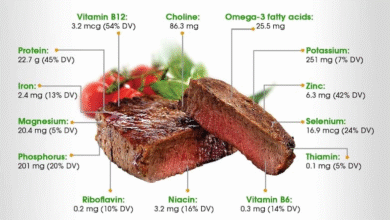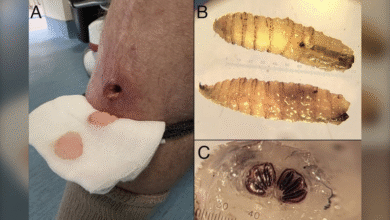Pneumonic Plague Claims Life in Arizona After 20 Years

Pneumonic plague, a highly contagious and deadly respiratory disease, has recently claimed its first victim in Arizona in nearly two decades, highlighting the ongoing risks associated with this ancient ailment. Identified in Coconino County, the resident’s death serves as a stark reminder of how plague transmission can manifest in modern settings, despite being relatively rare in the U.S. with only about seven cases reported annually. Pneumonic plague symptoms can escalate rapidly, leading to severe pneumonia and respiratory failure if left untreated. Fortunately, antibiotics for plague are available, allowing for effective treatment when diagnosed promptly. As health officials continue to monitor cases, awareness of this serious illness is essential to prevent further infections.
This recent incident emphasizes the dangers of one of the most severe forms of plague—pneumonic plague—which affects the lungs and can spread rapidly through airborne droplets. Known commonly as the lung-based variant of the illness, this formidable respiratory infection is caused by the same bacterium that led to countless deaths during the historic Black Death. Transmission occurs not only from flea bites but also through direct contact with infected animals, and in some cases, human-to-human transmission is possible. Understanding the nuances of symptoms associated with pneumonia stemming from plague is crucial for timely intervention. Managing outbreaks and ensuring the availability of effective treatments, including antibiotics, remains a priority for health organizations.
Understanding Pneumonic Plague: Causes and Risks
Pneumonic plague is a severe and often deadly form of the plague, primarily caused by the bacterium Yersinia pestis. This disease is primarily associated with pneumonia and can develop rapidly, often following the bubonic plague, which affects lymph nodes. The virus is primarily transmitted through the bites of infected fleas from wild rodents; however, it can also spread through respiratory droplets from an infected person. In recent incidents, the rise of cases in areas like Arizona highlights the necessity of understanding the risks and causes associated with pneumonic plague.
In Coconino County, where the recent pneumonic plague death was reported, health officials are particularly vigilant. The potential for transmission exists not just from animal to human interactions but also person-to-person, making close contact a significant risk factor. The symptoms of pneumonic plague can mimic conditions like pneumonia, leading to diagnostic challenges for healthcare providers, making awareness and early detection vital for effective treatment.
Symptoms of Pneumonic Plague: What to Look For
Recognizing the symptoms of pneumonic plague early can be critical for survival. The most common symptoms include a sudden onset of fever, chills, chest pain, shortness of breath, and a productive cough that may expel blood or mucus. As these symptoms closely resemble those of other respiratory infections, it’s essential for individuals, especially in areas prone to plague outbreaks, to seek medical attention if they experience such signs.
In addition to respiratory problems, pneumonic plague can lead to severe complications, such as respiratory failure. Hence, individuals exhibiting symptoms should be evaluated immediately for plague, especially in regions like Arizona where recent deaths have occurred. Physicians are trained to differentiate these symptoms from other types of pneumonia, particularly in patients with potential recent exposure to infected animals or fleas.
Plague Transmission: How the Disease Spreads
Plague transmission occurs through several vectors, primarily the bites of infected fleas that have fed on wild rodents, which are crustaceans of the disease. However, in the case of pneumonic plague, it can also spread through respiratory droplets, putting nearby individuals at risk. This mode of transmission is particularly dangerous, as it allows for person-to-person contact, underscoring the need for public health awareness in affected regions like Coconino County, Arizona.
Moreover, environmental factors play a significant role in plague transmission. Areas that have a high rodent population, especially in rural settings, are at an increased risk of outbreaks. Public health officials emphasize the importance of controlling rodent populations and minimizing human contact with these animals to reduce transmission risks. Understanding the factors involved in plague transmission can help create targeted prevention strategies, especially in areas where cases are increasing.
The Importance of Prompt Treatment: Antibiotics and Their Role
When diagnosed early, pneumonic plague can be effectively treated with a variety of antibiotics. Medications such as streptomycin and doxycycline have proven particularly effective against Yersinia pestis, the bacteria responsible for the disease. In light of the recent Arizona plague death, it is critical to emphasize that early detection and treatment are key to reducing mortality rates associated with pneumonic plague.
In regions like Coconino County, public access to adequate medical resources and information about plague symptoms can significantly impact treatment outcomes. Health officials encourage the public to be aware of the healthcare facilities available and to seek medical attention immediately when symptoms arise. The capacity to provide timely antibiotics for plague can save lives, preventing the disease from escalating into more severe forms.
Historical Context: The Plague and Its Impact
The historical context of the plague is essential to understanding its impact, particularly during the Black Death of the 14th century, which decimated populations across Europe. Today, while overcome by advancements in medicine, the threat of the plague still lingers in certain parts of the United States, including Arizona. This underscores the importance of public health efforts and education to identify and manage cases of pneumonic plague effectively.
Reflecting on past outbreaks can aid modern societies in crafting effective responses to new cases. Education surrounding the history of the plague, its transmission methods, and outbreak management can enhance public preparedness. In light of the recent Arizona case, it remains crucial for officials to ensure that communities are informed and ready to respond to such health crises.
Public Health Measures: Preventing Pneumonic Plague Outbreaks
Public health measures play a vital role in preventing pneumonic plague outbreaks. In affected areas like Coconino County, awareness campaigns can effectively educate residents on avoiding contact with wild rodents and minimizing flea exposure. Such preventive strategies could include housing modifications, pest control initiatives, and community awareness programs aimed at identifying and reporting any suspected rodent infestations or infected animals.
Moreover, enhancing surveillance systems to monitor both wildlife and human health indicators is crucial in early detection of plague cases. Public health departments can implement regular checks in rural areas known to harbor plague-carrying rodents, further preventing potential outbreaks before they escalate into public health crises. Community cooperation in these measures can significantly contribute to combating pneumonic plague.
The Role of Animal Control in Public Health
Animal control plays a pivotal role in managing public health concerning diseases like pneumonic plague. Effective control strategies involve monitoring and managing the populations of wild rodents, which are natural plague reservoirs. In regions such as Arizona, collaboration between public health officials and wildlife agencies can lead to sustainable management practices that reduce the risk of plague transmission to humans.
Furthermore, targeted educational programs aimed at pet owners and the local community about the importance of rodent control and hygiene can diminish the chances of exposure to the plague. By understanding how animal control measures align with public health policies, communities can foster safer environments that effectively reduce the risks associated with pneumonic plague and other zoonotic diseases.
Public Awareness Campaigns: Educating Communities on Plague Risks
Public awareness campaigns serve as a crucial tool in educating communities about the risks associated with pneumonic plague and other forms of the disease. Through curriculum programs, local workshops, and informational flyers, communities can be equipped with essential knowledge about recognizing symptoms, understanding transmission routes, and knowing when to seek medical attention. These educational initiatives are especially pertinent in areas with documented cases, such as Coconino County.
Effective campaigns also cover preventive measures, including the importance of keeping outdoor living spaces clean and rodent-free. Communities must be informed about the elevated risks posed during specific seasons when rodent populations peak. By engaging residents and sharing resources on how to protect their homes and health, public health advocacy can influence behavior and mitigate the potential spread of pneumonic plague.
Response Strategies: How Authorities Address Pneumonic Plague Cases
In response to pneumonic plague cases, local health authorities typically implement a multifaceted approach. This includes immediate epidemiological assessments to trace contacts and identify additional cases. Public health interventions also encompass educating the affected community about the signs and symptoms of pneumonic plague, while encouraging reporting any unusual respiratory illnesses or deaths.
Authorities may also conduct localized public health drills, engaging both medical professionals and first responders to ensure preparedness in case of an outbreak. This proactive strategy enables swift action should additional cases arise, fostering a well-informed community ready to handle potential health threats associated with pneumonic plague.
Frequently Asked Questions
What are the symptoms of pneumonic plague in patients?
Pneumonic plague symptoms typically include severe pneumonia, chest pain, cough, difficulty breathing, and possible coughing up of blood. Early detection is crucial for effective treatment, so anyone exhibiting these signs, especially in areas where pneumonic plague is reported, should seek medical attention immediately.
How is pneumonic plague transmitted to humans?
Pneumonic plague is primarily transmitted through flea bites from infected wild rodents. However, it can also spread via direct contact with an infected animal or even from person to person through respiratory droplets, especially in close quarters.
Is there a risk of pneumonic plague in Coconino County, Arizona?
Yes, there is a risk of pneumonic plague in Coconino County, Arizona, particularly following reports of a recent death due to the disease. The area, like others in the southwestern U.S., is known to harbor cases of plague transmitted by fleas from infected rodents.
What antibiotics are effective for treating pneumonic plague?
Antibiotics for plague treatment include streptomycin, gentamicin, doxycycline, and ciprofloxacin. Prompt treatment with these antibiotics can significantly improve outcomes for those infected with pneumonic plague.
How common is pneumonic plague in the United States?
Pneumonic plague is quite rare in the United States, with approximately seven cases diagnosed annually, mostly concentrated in rural areas of states such as New Mexico, Arizona, Colorado, and California.
Can pneumonic plague lead to severe health complications?
Yes, pneumonic plague can lead to severe health complications, including respiratory failure and potentially death if not treated promptly. Its quick progression highlights the importance of early detection and immediate medical care.
What measures can be taken to prevent pneumonic plague outbreaks?
Preventive measures against pneumonic plague outbreaks include reducing rodent populations, avoiding contact with wild animals, and using flea control products on pets. Awareness and education on the signs and symptoms of plague are also essential for early intervention.
| Key Point | Details |
|---|---|
| Recent Death | An Arizona resident died from pneumonic plague, marking the area’s first death in nearly 20 years. |
| Location | The victim lived in Coconino County, which includes Flagstaff. |
| Historical Context | The last death from pneumonic plague in Coconino County was in 2007. |
| Overall Incidence | Approximately seven cases of pneumonic plague are diagnosed annually in the U.S. |
| Geographic Distribution | Most cases are concentrated in the western states and are commonly found in rural areas of several states. |
| Transmission | Pneumonic plague is transmitted through flea bites, contact with infected animals, or person-to-person via respiratory droplets. |
| Severity | Pneumonic plague affects the lungs and is the most fatal form of plague. |
| Historical Impact | The plague caused millions of deaths during the Black Death in the 14th century but is now treatable with antibiotics. |
Summary
Pneumonic plague has resurfaced in Arizona with the recent death of a resident, highlighting the disease’s potential threat even in modern times. Although rare, the disease can be severe and fatal, especially if not treated promptly. Awareness of pneumonic plague’s symptoms and transmission methods is crucial, as it can spread through flea bites or even person-to-person contact. With its historical roots in the devastating Black Death, understanding and managing this disease remain essential.




